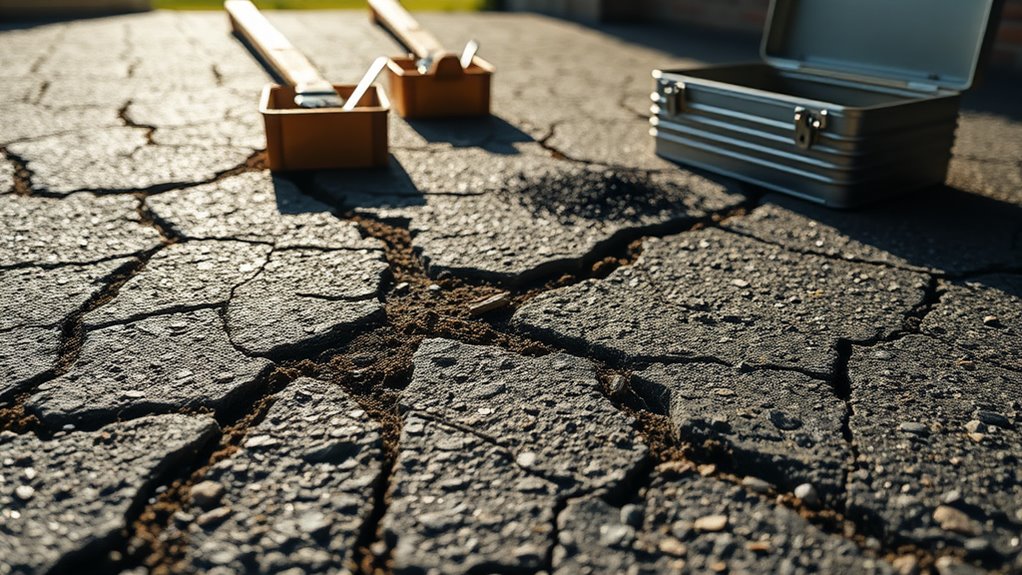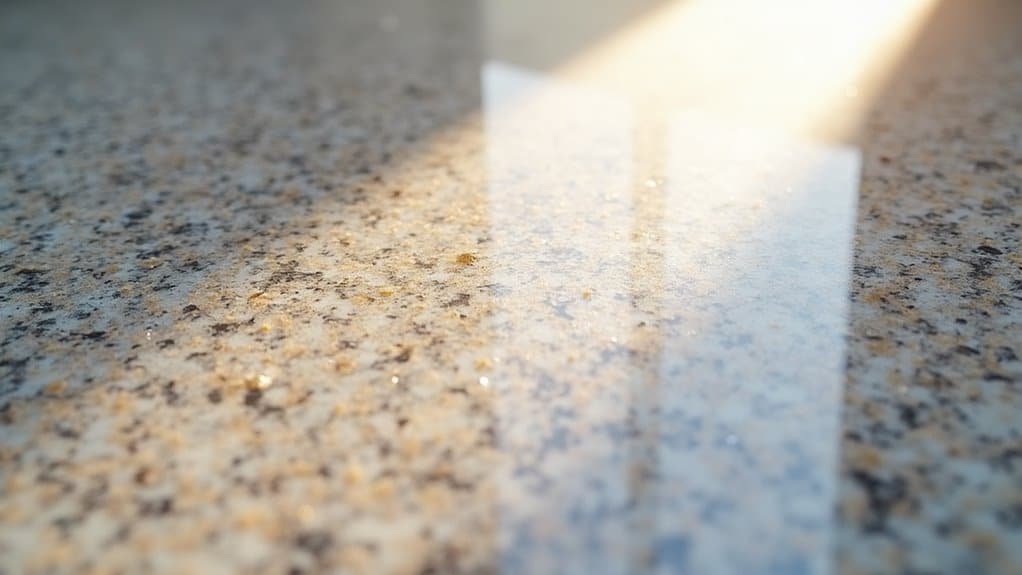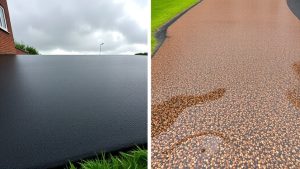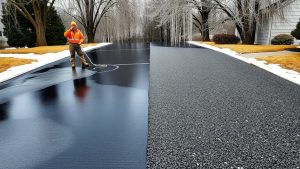Tarmac driveway cracks typically arise from poor installation, weather changes, or lack of maintenance. Fluctuating temperatures cause the tarmac to expand and contract, while moisture can weaken the asphalt. Additionally, roots from nearby trees or shrubs can worsen existing cracks, leading to more significant damage.
For repairs, sealing small cracks and filling in potholes is effective, and ensuring proper drainage is crucial. Regular inspections can help catch minor issues before they escalate. By understanding these factors, you can maintain the integrity of your driveway and enhance its longevity.
Table of Contents
ToggleKey Takeaways
Tarmac driveway cracks can occur due to substandard materials, improper installation, and insufficient site preparation, all of which compromise the driveway's integrity over time.
Environmental factors, such as fluctuating temperatures, heavy rain, and UV exposure, also play a significant role in tarmac deterioration, leading to cracks.
Regular maintenance, including routine inspections and timely repairs, is crucial to tackle minor issues before they turn into expensive problems. For instance, sealing the surface and ensuring effective drainage can prevent further cracking and prolong the driveway's life.
If you notice cracks larger than 2.5 cm, or if there's pooling water, potholes, or severe surface damage, it's advisable to seek professional help for urgent repairs.
Causes of Tarmac Driveway Cracks
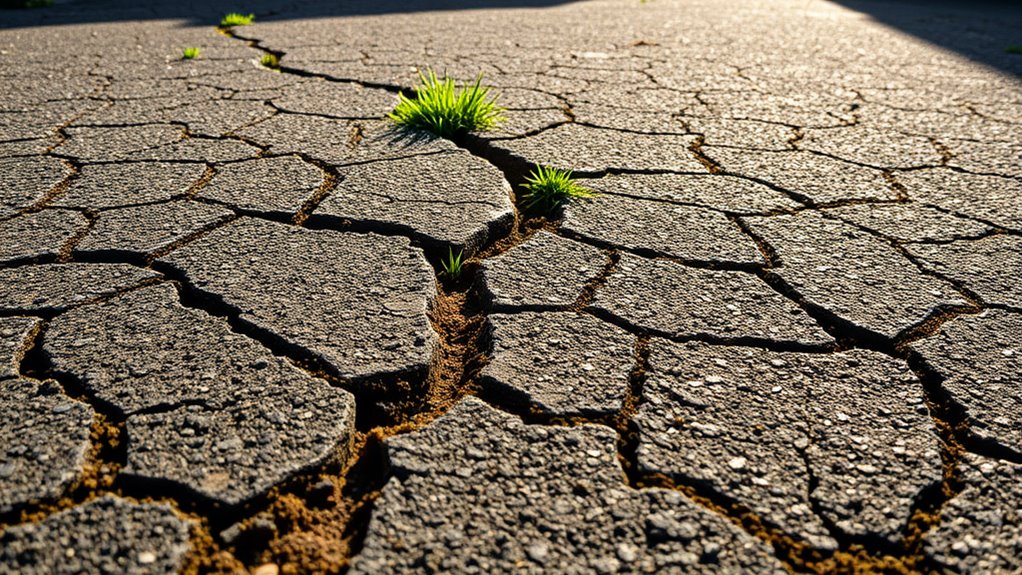
Tarmac driveway cracks can occur due to several factors that weaken their structure. Poor quality materials and installation issues, like an incorrect mix or insufficient compaction, can lead to problems. If the ground isn't properly prepared, it can settle unevenly, while unstable subgrade materials can create an uneven surface. Additionally, frequent heavy vehicle traffic can exceed the tarmac's load-bearing capacity, resulting in fatigue cracking. Plants can also worsen the situation, as roots may push through existing cracks. To help prevent these issues, it's essential to use high-quality materials and follow proper installation methods. Regular maintenance and promptly addressing any underlying problems can significantly extend the life of your tarmac driveway. Furthermore, poor drainage can exacerbate these issues by allowing water to accumulate and weaken the structure over time. Regular inspections can help identify early signs of damage that may lead to cracking if left unaddressed.
Weather Conditions Impacting Tarmac
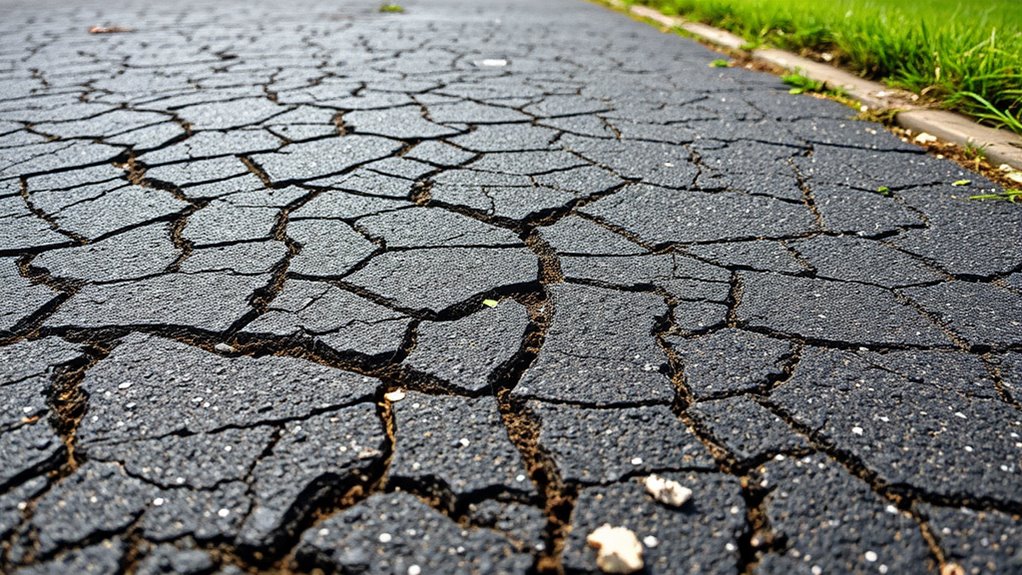
Weather conditions significantly affect the lifespan and performance of tarmac driveways. For instance, temperature changes cause tarmac to expand and contract, which can weaken its durability over time. Intense summer heat can make the tarmac soft and increase susceptibility to deformation under heavy loads.
Heavy rain can seep into cracks, undermining the base layer and resulting in potholes. Moreover, exposure to UV rays speeds up oxidation, making the surface brittle and more susceptible to cracking.
In areas with extreme weather, it's wise to adopt proactive measures to improve resilience. This includes choosing appropriate materials, ensuring effective drainage, and conducting regular inspections.
Maintenance practices like sealcoating and filling cracks can help reduce the risks of deterioration. By recognising these weather-related factors, you can maintain your tarmac driveway better, ensuring its longevity and structural integrity despite the elements.
Soil and Site Preparation Issues
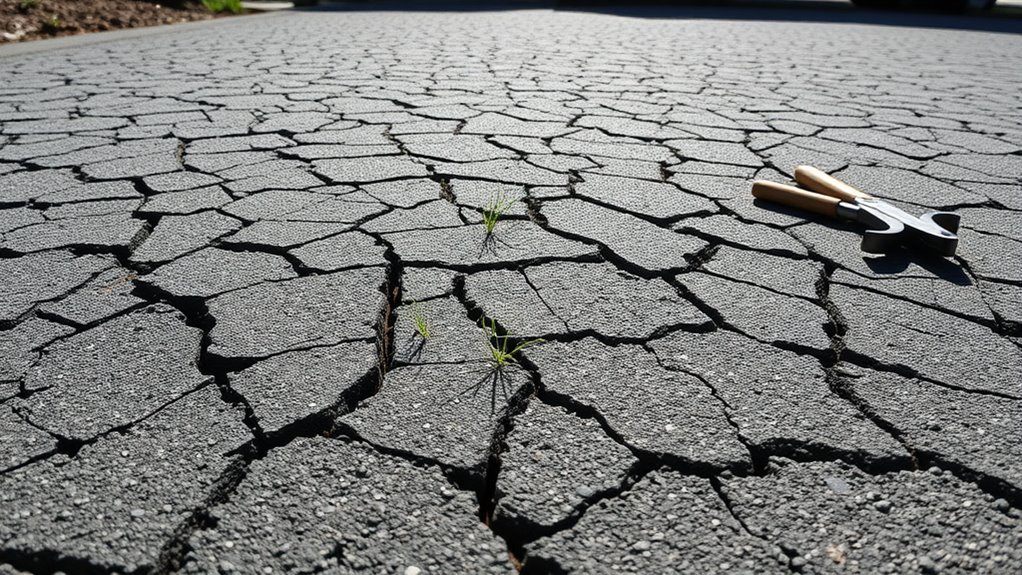
When planning a tarmac driveway, it's essential to address soil and site preparation issues to ensure durability and avoid cracking. Poor compaction of the subgrade can lead to settling and surface cracks. Using geotextile fabric for subgrade stabilization creates a strong foundation. Furthermore, ensuring a well-compacted sub-base is critical for tarmac installation.
Make sure to follow best practices for gravel installation; the gravel layer should be compacted evenly and maintained at a thickness of 10 to 15 cm, depending on the soil type.
Assess the site for drainage issues, as improper grading can cause water to pool, leading to damage. Clearing vegetation and ensuring proper edge preparation will help stabilize the driveway, reduce the risk of future cracks, and extend its lifespan.
Environmental Factors Contributing to Damage
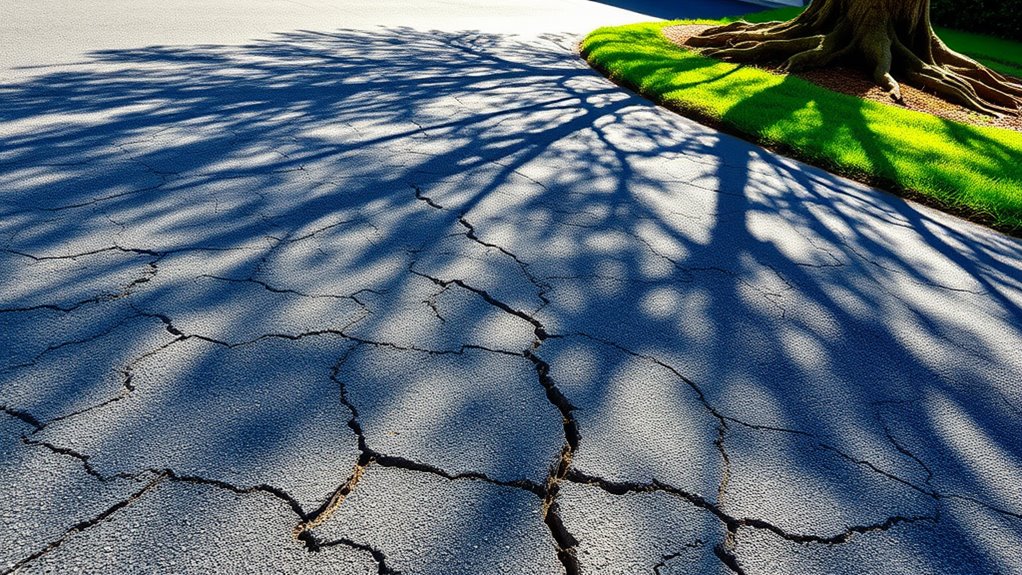
Environmental factors significantly affect the lifespan and condition of your driveway. Key elements like temperature changes, moisture levels, and traffic can lead to considerable damage.
- Temperature changes make asphalt expand and contract, resulting in cracks.
- Moisture build-up due to poor drainage weakens the asphalt, causing erosion and further cracking.
- Heavy traffic exacerbates these issues, increasing stress and leading to potholes.
These factors work together to compromise the driveway's structure, making it crucial to understand their impact.
Using the right asphalt mixtures and sealcoating can help reduce damage from temperature variations and moisture, extending the life of your driveway.
Regular maintenance and monitoring are essential to safeguard against these environmental challenges.
Common Missteps in Tarmac Maintenance
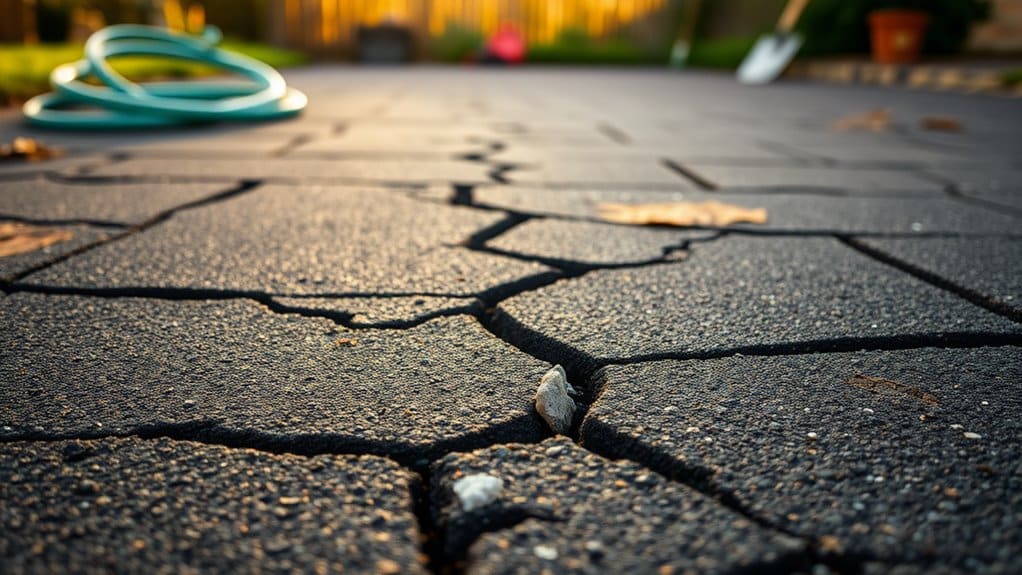
When maintaining your tarmac driveway, poor sealing practices can lead to quicker wear and cracking.
Using the wrong de-icing methods might damage the surface, and ignoring minor repair issues can cause them to escalate into expensive fixes.
It's vital to address these common pitfalls to ensure your tarmac remains in good condition for years to come.
Insufficient Sealing Practices
Properly sealing a tarmac driveway is crucial for its longevity, yet many homeowners make common mistakes that can undermine its effectiveness.
Key issues often stem from poor sealer choice and insufficient curing methods. To ensure a successful sealing process, consider the following:
- Select the Right Sealer: Using an appropriate sealer is vital for effective bonding and protection.
- Allow Enough Drying Time: Giving the sealer ample time to cure is essential; rushing this can lead to problems down the line.
- Thoroughly Prepare the Surface: Cleaning the tarmac before application enhances adhesion and durability.
Incorrect Deicing Methods
Using the wrong deicing methods can seriously damage your tarmac driveway, affecting its durability and structure.
While it might be tempting to use deicers like rock salt or calcium chloride for their quick results, their corrosive nature can harm the tarmac and surrounding plants.
Instead, opt for safer alternatives like magnesium chloride or potassium chloride, which are kinder to the environment.
Applying deicers correctly is crucial; pre-wetting dry deicers can boost their effectiveness, and using them at the right temperatures helps minimise damage.
Timing is also important—avoid applying them during windy conditions or when pavement temperatures fall below -9°C (15°F).
Neglected Repair Issues
Neglecting routine maintenance can lead to serious repair issues for your tarmac driveway. If you skip regular inspections and repairs, small problems can quickly escalate into costly ones.
Here are key areas to focus on:
- Regular Crack Inspections: Catch and fix cracks early to prevent them from worsening.
- Quality Repair Methods: Use good-quality sealants and apply them properly for effective repairs.
- Proper Drainage Solutions: Tackle any drainage problems to avoid water damage.
Overlooking these aspects not only increases the frequency of repairs but also shortens the lifespan of your driveway.
Prioritise maintenance to keep your tarmac in good shape. Staying on top of these tasks can save you money on expensive repairs and ensure your driveway lasts longer.
Repair Techniques for Tarmac Cracks
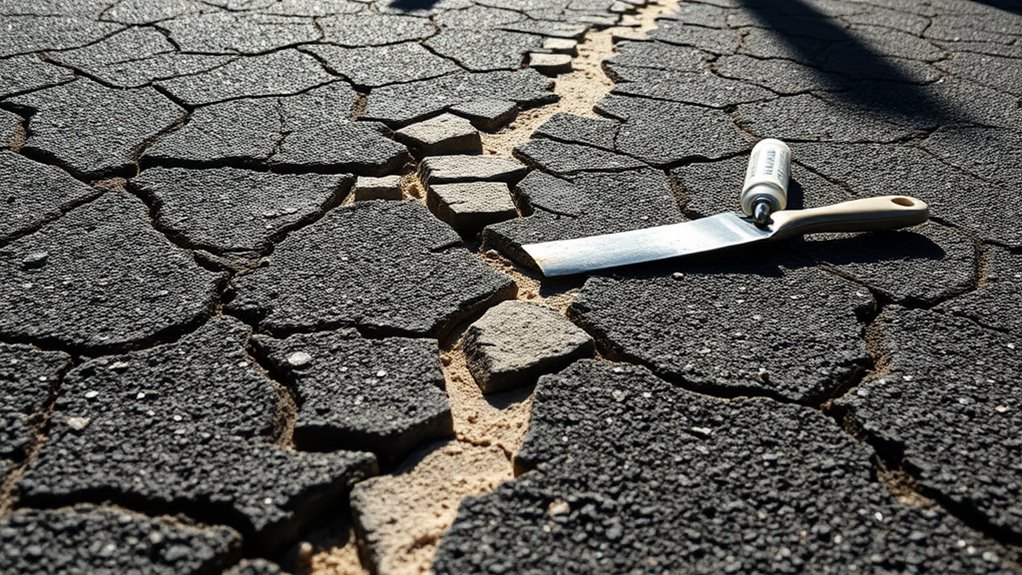
Repairing tarmac cracks effectively requires a straightforward approach for lasting results.
Start by assessing the crack to determine the damage's severity, whether caused by weather, heavy traffic, or underlying issues. For small cracks, use cold pour crack fillers; for larger holes, opt for tarmac patching compounds.
For minor repairs, clean the crack, apply the filler, and smooth it out.
For deeper cracks, remove any debris, overfill with cold-lay tarmac, and compact it to match the surrounding surface. Remember to seal the repaired areas to prevent further damage.
If the damage is significant, it may be wise to hire professionals for a more durable solution.
Preventative Measures for Tarmac Driveways
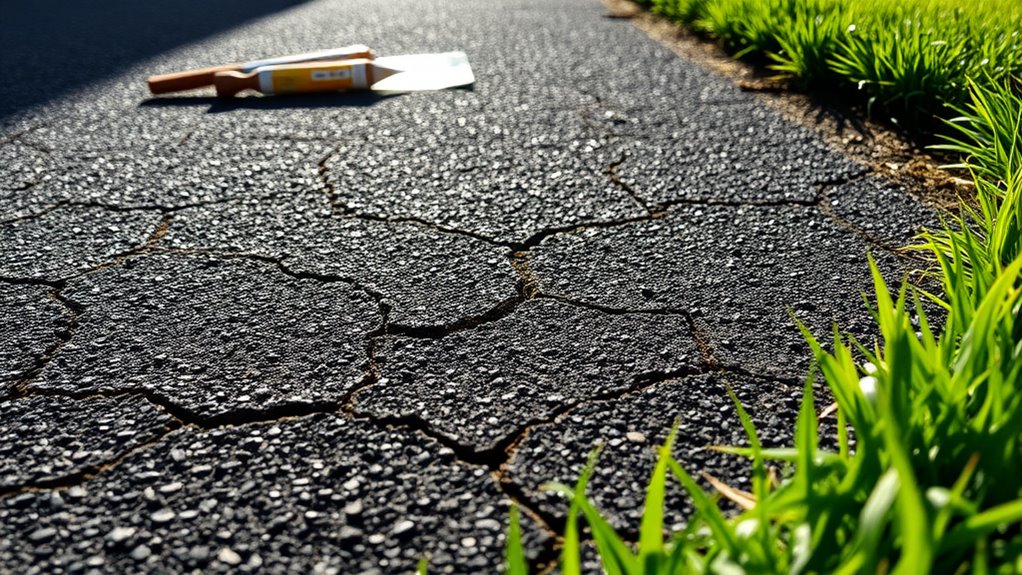
To keep your tarmac driveway in good condition, regular inspections are crucial for spotting potential problems early.
It's also important to manage nearby trees to prevent root damage and debris build-up, which can harm the surface.
Regular Inspections Importance
Regular inspections may seem like a chore, but they're vital for keeping your tarmac driveway in good shape. By sticking to a regular inspection schedule, you can enjoy several benefits:
- Preventative Maintenance: Spotting small problems before they turn into big ones.
- Safety and Liability: Minimising hazards that might cause accidents.
- Cost Savings: Avoiding hefty repair bills by tackling issues early.
These inspections not only improve the look of your driveway but also help it last longer.
For instance, catching cracks or drainage problems early allows for prompt repairs, which can stop moisture damage and weed growth.
Tree Management Strategies
Regular inspections can help identify potential threats to your tarmac driveway, especially from nearby trees.
Effective tree management starts with strategic placement. Ensure trees are planted at a safe distance to minimise root encroachment. Understanding the expected root zone during driveway planning is crucial for maintaining its integrity.
Using root barriers made from materials like high-density polyethylene can redirect root growth away from the tarmac, protecting it from damage.
Install these barriers vertically around the root zone, preferably during the initial construction. Keep an eye out for signs of root intrusion and consult an arborist for advice on maintaining tree health without compromising your driveway.
Taking proactive measures will significantly reduce the risk of cracks and heaving caused by tree roots.
Signs Your Tarmac Needs Repair
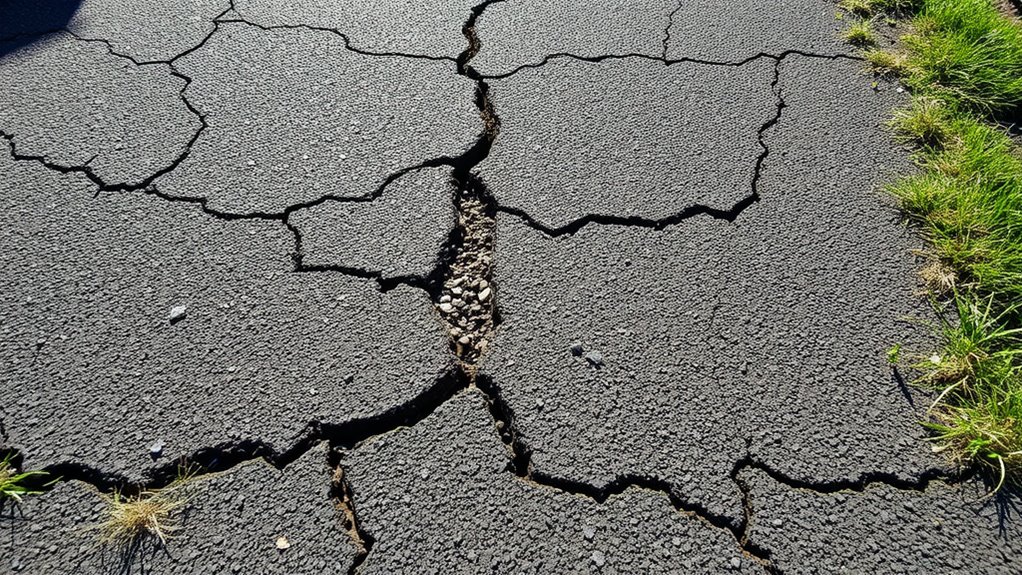
When you spot cracks in your tarmac driveway, it's important to take action quickly, as these can often indicate more serious underlying issues.
Here are some clear signs that your tarmac may need repairing:
- Pooling water can signal drainage problems, which may worsen existing cracks.
- Potholes show significant surface damage that requires urgent attention.
- Alligator skin patterns indicate severe cracking and may necessitate resurfacing.
Ignoring these signs can lead to higher maintenance costs and structural problems.
Timely repairs not only improve the look of your driveway but also extend its lifespan, helping you avoid further damage and expensive repairs down the line.
When to Seek Professional Help
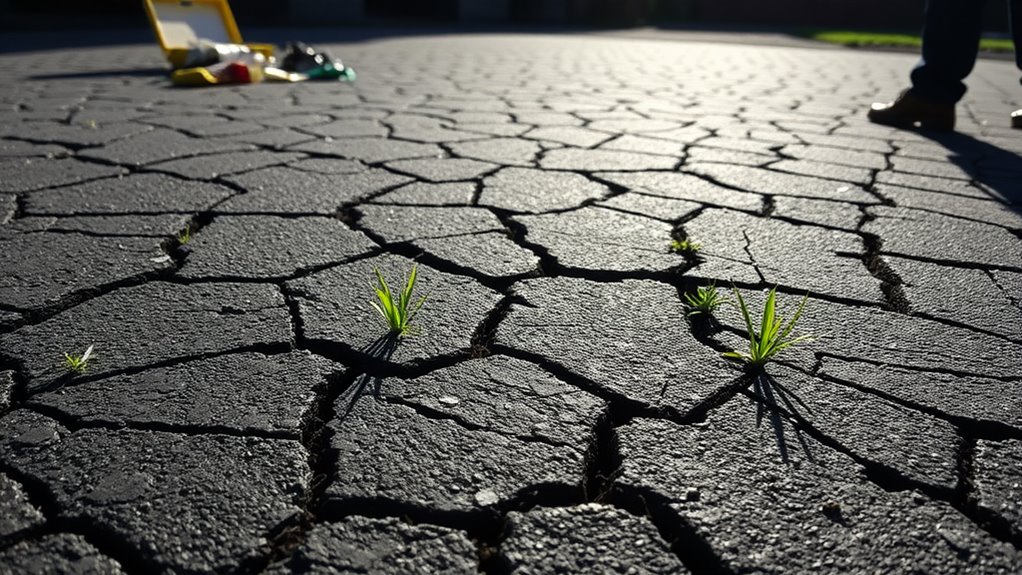
When should you call in professionals for your tarmac driveway? If you see cracks wider than 2.5 cm or significant potholes, it's essential to get a professional assessment.
Extensive areas of crumbling asphalt or drainage issues signal the need for urgent repairs. If you notice ruts or depressions, this could indicate underlying base problems that only experts can properly address.
If you're unsure about the severity of the damage, it's best to consult a professional. They've the right tools and techniques to provide more durable solutions than DIY fixes, ensuring your driveway stays safe and functional.
Don't wait too long; acting promptly can help prevent further damage.
Frequently Asked Questions
How Often Should I Seal My Tarmac Driveway?
For tarmac maintenance, it's best to seal your driveway every two to three years. However, factors like traffic levels, weather conditions, and visible wear can affect this schedule. For instance, if your driveway sees a lot of vehicles or is exposed to harsh weather, you may need to seal it more frequently to ensure proper protection and longevity.
Can I Repair Tarmac Cracks in Winter?
Yes, you can repair tarmac cracks in winter, but it can be challenging. To ensure a lasting repair, you need to prepare the area properly, use the right materials, and be mindful of moisture levels. For example, if the ground is wet or frost is present, it can affect the effectiveness of the repair. While it's possible to do it, consider waiting for milder weather for the best results.
What Is the Average Lifespan of a Tarmac Driveway?
A tarmac driveway usually lasts between 15 to 20 years, depending on factors such as installation quality, traffic levels, and local climate. With regular maintenance, you could extend its lifespan to 25 years or more. For instance, filling in cracks and resealing every few years can make a significant difference.
How Do I Choose the Right Sealant for My Driveway?
Choosing the right sealant for your driveway is crucial—it's like picking the right protection for your home. Start by assessing the different types of sealants available, such as asphalt or concrete sealers. Think about how you'll apply it; some products are easier to use than others. Lastly, focus on durability to ensure your driveway can handle the UK weather, from heavy rain to frost. This way, you'll keep your driveway looking good and lasting longer.
Will Adding a Layer of Gravel Help Prevent Cracks?
Adding a layer of gravel can improve driveway maintenance by creating a stable base, which helps minimise shifting and sinking. While it won't directly stop cracks from forming, it does enhance overall stability, potentially extending your driveway's lifespan against environmental pressures. For instance, think of it like laying a solid foundation for a house; it supports the structure and reduces the risk of damage over time.
Conclusion
When it comes to maintaining your tarmac driveway, think of cracks as warning signs. Just as regular check-ups keep your health in check, frequent inspections and timely repairs help keep your driveway in good condition. By knowing what causes these cracks and taking proper care, you can stop small issues from turning into big problems. Stay alert and act quickly, and your driveway will remain a reliable surface, showcasing your commitment to upkeep.
Prepare the perfect base for your resin bound stone installation and discover the crucial factors that ensure lasting durability.
Know where resin bound surfacing can transform spaces for both residential and commercial use, and discover the countless benefits that Read more
A stone carpet combines beauty and resilience in flooring, but what makes quartz floors uniquely beneficial? Discover the secrets behind Read more

